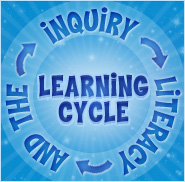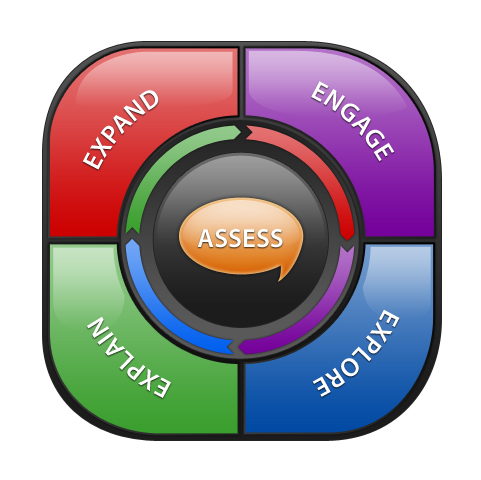MiddleSchoolPortal/Inquiry, Literacy and the Learning Cycle
From NSDLWiki
<keywords content="middle school science inquiry literacy learning cycle nature of science methods conceptual understanding standards asking questions interpreting data inferring using logic drawing conclusions" />
<metadescription content="This free, standards-based, online publication, developed for middle school science teachers, describes how inquiry is a powerful instructional strategy that, through the learning cycle approach, facilitates the integration of literacy in a meaningful, authentic way." />
Introduction
There are many misconceptions about inquiry as an instructional strategy that ultimately prevent teachers from adopting it. The term itself can conjure up a mental image of a teacher dumping a bunch of materials on a table and telling the students to use them to "learn something." In fact, this is actually what I thought inquiry to be when I first heard of the strategy. "How can anyone ever learn?" I wondered. "Won't the students end up off-task? And what about the standards I'm expected to teach?"
Contents |
Turns out I had a lot to learn about inquiry. Even though I majored in the biological sciences in college, I wasn't really familiar with the strategy. My professors almost exclusively relied on a read-the-textbook-and-lecture approach to learning the content. Many of my laboratory classes took a "cookbook" approach in which we just had to follow the directions and find the correct answer. A few classes, I now realize, were inquiry-based, but the content was challenging and I didn't appreciate or understand the different approach. And the science methods courses in my master's program didn't focus on inquiry, either. It wasn't until much later that I had a chance to explore the strategy in depth. What I have learned is: inquiry is a powerful instructional strategy that, through the learning cycle approach, facilitates the integration of literacy in a meaningful, authentic way.
Inquiry
What is inquiry? It's difficult to sum up a complex topic in a single phrase or sentence. The National Research Council (2000) explains:
Inquiry refers to the activities of students in which they develop knowledge and understanding of scientific ideas, as well as an understanding of how scientists study the natural world.
This statement points to several perspectives on inquiry: inquiry as a teaching strategy, the abilities necessary to do inquiry, and an understanding of how scientists perform their work (scientific inquiry). These perspectives are reflected in the National Science Education Standards (NRC, 1996). Each grade band's Content Standard A: Science as Inquiry contains both abilities and understandings related to inquiry. Teachers are also encouraged to adopt inquiry as a teaching strategy for the other content standards.
But that still doesn't help us understand exactly what inquiry is all about. Instead of searching for a definition, let's consider the essential features of inquiry. The National Research Council (2000) identified five essential features of inquiry:
1. Learner engages in scientifically oriented questions.
2. Learner gives priority to evidence in responding to questions.
3. Learner formulates explanations from evidence.
4. Learner connects explanations to scientific knowledge.
5. Learner communicates and justifies explanations.
Let's examine each of these features in detail.
Feature 1: Scientifically Oriented Questions
Inquiry always begins with questions. But not just any questions - scientifically oriented questions. Others term them testable questions or productive questions. Regardless of the name used, these questions focus on the natural world, lend themselves to investigation, and involve the collection and analysis of data to formulate explanations. Scientifically oriented questions are open-ended, involving more than a "yes" or "no" response. They often allow for more than one correct response.
Posing appropriate questions is challenging for students (and teachers as well). Students tend to ask a lot of "why" questions (Why is the sky blue?), which cannot be answered through inquiry. Teachers can help students rephrase these questions into "how" questions (How does sunlight help plants grow?) that are better suited for scientific inquiry.
Above all, questions should be engaging and relevant to the students, their interests, and their life experiences.
Feature 2: Evidence
In inquiry, students collect a wide variety of evidence. They make observations and describe objects like rocks, the position of the sun, or the appearance of the moon. They measure quantities such as time, temperature, or distance traveled. This evidence is used to then construct explanations for scientific phemonema.
Not all evidence is collected firsthand. Sometimes, students will obtain evidence indirectly. They might find data in a text or web page, or be given data by their teacher. This is particularly helpful when conditions prevent students from obtaining evidence directly.
Evidence might also be qualitative or quantitative. While we typically assume that data is quantitative - temperatures, time, measurements - descriptive observations can also be quite useful.
Feature 3: Explanations
Once students have collected and analyzed evidence, they develop explanations based on this evidence. Explanations provide causes for observed effects, or establish relationships between variables. Explanations are built upon prior knowledge, but go beyond to state something new. A useful strategy described by Michael Klentschy in Using Science Notebooks in Elementary Classrooms and Using Science Notebooks in Middle School is to use t-charts to help students link their explanations (or claims) to evidence.
Feature 4: Scientific Knowledge
An essential (and often overlooked) feature of inquiry in the classroom is evaluating explanations in light of alternative explanations. Students should be able to consider alternative explanations proposed by classmates or by the scientific community. They should be able to revise their own explanations in light of discussions, questions, and new data - or eliminate an explanation if it does not hold up to scrutiny. Teachers can help their students with this challenging feature by modeling the process and providing time for structured (and scaffolded) conversation.
Feature 5: Communication
The last feature requires students to share their questions, procedures, evidence, and explanations with others. This may be accomplished through science notebooks, lab reports, conversations, PowerPoint presentations, or even nontraditional avenues such as blogging and podcasting. Teachers should consider how they can allow students to communicate with classmates or even the larger community. Broadening the audience beyond the teacher adds authenticity to the task and can motivate students. It also provides further opportunity for reflection and critical thinking.
While inquiry is defined by these five features, it is a flexible strategy. One of the misconceptions about inquiry is that it consists of handing students materials and telling them to "go learn something." Actually, inquiry can range from "closed" (teacher-guided) to "open" (student-guided), along a continuum - the inquiry continuum.
A single lesson may fall at different points across the continuum, depending on the particular feature of inquiry in question. Teachers may purposefully design inquiry experiences to be teacher-directed at some points to provide support for features that students struggle with. Other features might be more student-directed. Using this continuum to rate and design experiences allows teachers to provide appropriate amounts of scaffolding for their students.
The Learning Cycle
The learning cycle is a teaching strategy for using inquiry in the science classroom. Created in the late 1950s and early '60s, there are several variations of the cycle used today. We'll discuss a 5E learning cycle approach, although 3E, 4E, and even 7E versions exist.
The 5E learning cycle consists of five phases: Engage, Explore, Explain, Expand, and Evaluate (or Assess).
Image courtesy of the Ohio Resource Center.
Engage
The goal of this phase is to set up motivating circumstances and instill a "need to know" in students. Teachers might use a KWL chart to access prior knowledge, or discrepant events to capture attention and stimulate thinking. The Engage phase should also set a focus for the remainder of the lesson.
Explore
This phase involves active involvement with science content. Students are asking questions and investigating them by manipulating materials, making observations, and keeping records. Many of the science process skills, such as observing, measuring, and controlling variables, are used in this phase. Note that during this phase, students should not be expected to have mastery of new content or vocabulary terms. Instead, they are in the process of developing expertise through inquiry.
Explain
In this phase, students develop, solidify, and communicate their new understandings. Teachers use guiding questions to help students move from preconceptions to scientifically accurate conceptions. Students should be expected to demonstrate mastery of new concepts and vocabulary terms at this point. Reading, writing, and discussion are all part of the Explain phase.
Expand
This phase is often neglected in the rush to check off standards and move on to the next topic. However, it represents an important step in the development of scientific understanding and should not be omitted. In the Expand phase, students deepen their understanding, make connections, and apply their new knowledge to real-world or novel situations. They also might identify new questions for additional investigation. Teachers might use a teacher-directed Expand phase to seamlessly transition to the next topic of study according to the curriculum.
Evaluate (Assess)
Regardless of what you call it, this phase involves determining whether or not students met the standards addressed in the lesson or unit. Some applications of the learning cycle place this phase in the center of a circular diagram to indicate that assessment happens at all phases. The use of formative assessment helps teachers make decisions about pacing and sequencing, and summative assessment provides data about student mastery and achievement.
Integrating Literacy
Literacy - encompassing reading, writing, and speaking - can be integrated into all phases of the learning cycle. Students can read texts and web pages and analyze infographics to learn background information, learn how to design an experiment, or confirm and extend the knowledge gained. Opportunities for writing include science notebook entries, the creation of charts, tables, diagrams, and other infographics, and the production of formal lab reports or other ways of sharing what they've learned. Conversations and discussions are used to generate questions, activate background knowledge, share data, and present and critique explanations. Teachers should think about how they can use the opportunities presented by the phases of the learning cycle to engage students in authentic reading, writing, and conversation.
Resources
Implementing the Inquiry Continuum in the Classroom
Inquiry, Literacy, and the Learning Cycle web seminar
Why Does Inquiry Matter? Because That’s What Science Is All About by BSCS
References
National Research Council (NRC). 2000. Inquiry and the National Science Education Standards. Washington, DC: National Academy Press. http://books.nap.edu/openbook.php?record_id=9596&page=R1
National Research Council (NRC). 1996. National Science Education Standards. Washington, DC: National Academy Press. http://www.nap.edu/openbook.php?record_id=4962
Author and Copyright
Jessica Fries-Gaither is an education resource specialist and the project director of Beyond Penguins and Polar Bears, a NSF-funded project that helps elementary teachers integrate science and literacy. Post a comment on Jessica's MSP2 wall - http://www.msteacher2.org/profile/JessicaFriesGaither.
You can also email comments to msp@msteacher.org.
Connect with colleagues at our social network for middle school math and science teachers at http://msteacher2.org.
Copyright May 2011 - The Ohio State University. This material is based upon work supported by the National Science Foundation Grant No. 0840824. Any opinions, findings, and conclusions or recommendations expressed in this material are those of the author(s) and do not necessarily reflect the views of the National Science Foundation.


